Geology and Mining: A Symbiotic Cooperation?!
Abstract
:1. Introduction
2. Exploration Stage
3. Feasibility and Mine Design Stage
4. Mining Stage
4.1. Grade Control
- Sector I: Correctly classified as economic; the blocks are mined as ore;
- Sector II: Incorrect classification since the blocks are classified as uneconomic (below the cutoff limit xc) and are not mined, although their actual grades lie above the cutoff grade;
- Sector III: Correctly classified as uneconomic; the blocks are not mined;
- Sector IV: Incorrect classification since the blocks are classified as economic (above the cutoff xc) and are mined, although they are uneconomic.
4.2. Selective Underground Mining
- lead concentrate—good payment for lead and silver, progressively increasing penalties for mercury, a limited amount of concentrates acceptable by the smelter;
- mixed lead–zinc concentrate—moderate payment for lead, silver, and zinc; moderate penalty for mercury, limitation of maximum mercury content and the amount of concentrates acceptable by the smelter;
- zinc concentrate—good payment for zinc, moderate payment for silver, low penalty for mercury, no limitation in the amount of concentrates.
4.3. Further Exploration during the Exploitation Phase
5. Waste Management
6. Artisanal and Small-Scale Mining
7. Conclusions
- ○
- In the exploration stage, the geologist has to grasp the relevance of rules of thumb for investment and operating costs in order to optimize these stages and arrive at the correct go/no-go decisions at every milestone. Similarly, in the production phase, the mining engineer has to understand the learning curve of exploring a deposit in production in order to identify the optimum between profitability and the lifetime of the mining operation;
- ○
- In the feasibility and mine design stage, close cooperation is essential in order to minimize losses and dilution.
- ○
- In the mining stage, interaction must continue to realize the estimated grade as closely as possible. The more complex the orebody and the more selective the exploitation, the closer this interaction must be;
- ○
- Geological and engineering aspects must be considered in order to minimize the environmental effects of managing waste and the potential effects of the mine site following its closure;
- ○
- Artisanal and small-scale mining (ASM) in developing countries, which provides work for many more people than industrial mining, is coming under increasing pressure due to the requirements of industrialized consumer countries to improve social and environmental standards along the trading chains. Here, geologists and mining engineers can assist jointly with audits to enable ASM to find markets for its production. They can also help diffuse the frequent tension between industrial mining and ASM and help determine strategies for their peaceful coexistence.
Funding
Acknowledgments
Conflicts of Interest
References
- UN. UN Department of Economic and Social Affairs- Sustainable Development: The 17 Goals; UN: New York, NY, USA, 2022; Available online: https://sdgs.un.org/goals (accessed on 23 March 2022).
- NRC: National Research Council of the National Academies. Minerals, Critical Minerals, and The U.S. Economy. Prepublication Version; The National Academies Press: Washington DC, WA, USA, 2007; Available online: http://www.nma.org/pdf/101606_nrc_study.pdf (accessed on 23 March 2022).
- Lottermoser, B. Predicting Acid Mine Drainage: Past, Present, Future. Glückauf Min. Rep. 2015, 151, 480–489. [Google Scholar]
- Scholz, R.W. Environmental Literacy in Science and Society—From Knowledge to Decisions; Cambridge University Press: Cambridge, UK, 2011; p. 631. [Google Scholar]
- Scholz, R.W. The normative dimension in transdisciplinarity, transition management, and transformation sciences: New roles of science and universities in sustainable transitioning. Sustainability 2017, 9, 991. [Google Scholar] [CrossRef] [Green Version]
- McQuiston, F.W., Jr.; Bechaud, L.J., Jr. Metallurgical sampling and testing. In Surface Mining; Pfleiderer, E.P., Ed.; American Institute of Mining, Metallurgical and Petroleum Engineers: New York, NY, USA, 1968; pp. 103–121. [Google Scholar]
- Gutzmer, J. Geometallurgie—Warum Metallurgen mit Geowissenschaftlern kommunizieren sollten. 46. Schr. GDMB 2013, 133, 1–10. [Google Scholar]
- Pell, R.; Tijsseling, L.; Goodenough, K.; Wall, F.; Dehaine, Q.; Grant, A.; Deak, D.; Yan, X.; Whattoff, P. Towards sustainable extraction of technology materials through integrated approaches. Nat. Rev. Earth Environ. 2021, 2, 665–679. [Google Scholar] [CrossRef]
- Hoal, K.E.O.; Frenzel, M. Ores Drive Operations—Economic Geology Is the Foundation of Geometallurgy. SEG Discovery 2022, 129, 30–43. [Google Scholar]
- IEA: International Energy Agency 2021—The Role of Critical Minerals in Clean Energy Technology, World Energy Outlook Special Report. 2021. Available online: https://iea.blob.core.windows.net/assets/24d5dfbb-a77a-4647-abcc-667867207f74/TheRoleofCriticalMineralsinCleanEnergyTransitions.pdf (accessed on 9 June 2022).
- Sharma, R. Deep-Sea Mining: Current Status and Future Considerations. In Deep-Sea Mining: Resource Potential, Technical and Environmental Considerations; Sharma, A., Ed.; Springer International Publishing: Cham, Switzerland, 2017; pp. 3–21. [Google Scholar]
- Kuhn, T.; Wegorzewski, A.; Rühlemann, C.; Vink, A. Composition, Formation, and Occurrence of Polymetallic Nodules. In Deep-Sea Mining: Resource Potential, Technical and Environmental Considerations; Sharma, A., Ed.; Springer International Publishing: Cham, Switzerland, 2017; pp. 23–63. [Google Scholar]
- Buchholz, P.; Wellmer, F.-W.; Bastian, D.; Liedtke, M. Leaning against the wind: Low-price benchmarks for acting anticyclically in the metal markets. Miner. Econ. 2020, 33, 81–100. [Google Scholar] [CrossRef]
- ISA. Environmental Impact Assessments. 2022. Available online: https://www.isa.org.jm/environmental-impact-assessments (accessed on 5 June 2022).
- Sames, W.; Wellmer, F.-W. Exploration I: Nur wer wagt, gewinnt—Risiken, Strategien, Aufwand, Erfolg. Glückauf 1981, 117, 580–589. [Google Scholar]
- Harvey, T. When is enough, enough? Preview 2018, 117, 39–40. [Google Scholar] [CrossRef] [Green Version]
- Wellmer, F.-W.; Dalheimer, M.; Wagner, M. Economic Evaluations in Exploration; Springer: Berlin/Heidelberg, Germany, 2008; p. 250. [Google Scholar]
- Wellmer, F.-W.; Drobe, M. A quick estimation of the economcs of exploration projects—Rules of thumb for mine capacity revisited-the input for estimating capital and operating costs. Boletín Geol. Min. 2019, 130, 7–26. [Google Scholar] [CrossRef]
- Mular, A.L. Mining and Mineral Processing Equipment Costs and Preliminary Cost Estimations; Canadian Institute of Mining and Metallurgy: Montreal, QC, Canada, 1982; Volume 25, p. 265. [Google Scholar]
- BGR. Raw Materials Databank; BGR, Federal Institute of Geosciences and Natural Resources: Hannover, Germany, 2018.
- Taylor, H.K. Rates of working of mines—A simple rule of thumb. Trans. Inst. Min. Metall. 1986, 95, A203–A204. [Google Scholar]
- Long, K.R. A Test and Re-Estimation of Taylor’s Empirical Capacity-Reserve Relationship. Nat. Resour. Res. 2009, 18, 57–63. [Google Scholar] [CrossRef]
- Long, K.R. Taylor’s Rule Revisited. The future for mining in a data-driven world, Society for Mining, Metallurgy and Exploration. In Proceedings of the 2016 SME Annual Conference and Expo, Phoenix, AZ, USA, 21–24 February 2016; p. 206. [Google Scholar]
- Krige, D.G. Statistical applications in mine valuation. J. Inst. Mine Surv. S. Afr. 1962, 12, 45–84, 95–136. [Google Scholar]
- Van, J.; Guibal, D. Beyond ordinary kriging—An overview of non-linear estimation. In Beyond Ordinary Kriging: Non-Linear Geostatistical Methods in Practice; The Geostatistical Association of Australasia: Perth, Australia, 1998; pp. 6–25. [Google Scholar]
- Tolosana-Delgado, R.; Mueller, U.; Van den Boogaart, K.G.; Ward, C.; Gutzmer, J. Improving processing by adaptation to conditional geostatistical simulation of block compositions. J. S. Afr. Inst. Min. Metall. 2015, 115, 13–26. [Google Scholar] [CrossRef]
- Bourgault, G. Clarifications and New Insights on Conditional Bias. Math. Geosci. 2021, 53, 623–654. [Google Scholar] [CrossRef]
- Verly, G.; Parker, H.M. Conditional Simulation for Mineral Resource Classification and Mining dilution Assessment from the Early 1990s to Now. Math. Geosci. 2021, 53, 279–300. [Google Scholar] [CrossRef]
- Wellmer, F.-W. Statistical Evaluations in Exploration for Mineral Deposits; Springer: Berlin/Heidelberg, Germany, 1996; p. 379. [Google Scholar]
- Stewart, P.C.; Trueman, R. Strategies for minimising and predicting dilution in narrow vein mines—The narrow vein dilution method. In Proceedings of the Narrow Vein Mining Conference 2008, Ballarat, VIC, Australia, 14–15 October 2008; Volume 10, pp. 14–15. Available online: https://www.semanticscholar.org/paper/Strategies-for-Minimising-and-Predicting-Dilution-%E2%80%93-Stewart-Trueman/91e1b644e1fa8f5ae266907125d47693a5e55ddb (accessed on 1 March 2022).
- Loeb, J. Minimizing Mining Dilution, Ore Loss, and Misclassification by Accounting for Blast Movement in South American Porphyry-Skarn and Manto Copper Mines. Conference. Perumin 33. Convencion Minera 2017. Available online: https://www.researchgate.net/publication/327592841_Minimizing_Mining_Dilution_Ore_Loss_and_Misclassification_by_Accounting_for_Blast_Movement_in_South_American_Porphyry-Skarn_and_Manto_Copper_Mines (accessed on 17 March 2022).
- Salmenmaki, P. Reducing Dilution with Narrow-vein Mining. Eng. Min. J. 2018, 219, 42–45. [Google Scholar]
- Limpert, E.; Stahel, W.A.; Abbt, M. Log-normal Distributions across the Sciences: Keys and Clues. BioScience 2001, 51, 341–352. [Google Scholar] [CrossRef]
- Singer, D.A. The lognormal distribution of metal resources in mineral deposits. Ore Geol. Rev. 2013, 55, 80–86. [Google Scholar] [CrossRef]
- Taylor, H.K. General background theory of cut-off grades. Inst. Min. Metall. Trans. 1972, 81, A160–A179. [Google Scholar]
- David, M. Geostatistical Ore Reserve Estimation; Developments in Geomathematics 2; Elsevier: Amsterdam, The Netherlands, 1977; p. 364. [Google Scholar]
- Davis, J.G. Grade Control for Australian Open Pit Gold Mines; Geological Society: London, UK, 1992; Volume 63, pp. 219–232. [Google Scholar]
- Glasson, M.J.; Formerly Metallgesellschaft of Australia Pty. Ltd, Melbourne, Australia. Personal Communication, 2022.
- Glasson, M.J.; Lehne, R.W.; Wellmer, F.-W. Gold Exploration in the Callion Area, Eastern Goldfields, Western Australia. J. Geochem. Explor. 1988, 31, 1–19. [Google Scholar]
- Clark, F.; Carswell, J.T. Using reverse circulation drilling to improve sampling in a complex underground gold operation—An innovative approach to underground grade control at the Sunrise Dam mine, Western Australia. In Proceedings of the 9th International Mining Geology Conference 2014, Melbourne, Australia, 18–20 August 2014; AusIMM: Carlton, VIC, Australia, 2014; pp. 143–152. [Google Scholar]
- Schwan, P.B. The application of ditch witch sampling in oxidised open cut gold mines. In Equipment in the Minerals Industry: Exploration, Mining, and Processing Conference; AusIMM Symposium Series (October 1987); The AusIMM Kalgoorlie Branch: Kalgoorlie, WA, Australia, 1987; Volume 54, pp. 25–32. [Google Scholar]
- Boucher, A.; Dimitrakopoulos, R. Block Simulation of Multiple Correlated Variables. Math. Geosci. 2009, 41, 215–237. [Google Scholar] [CrossRef]
- Costelloe, M. Environmental Review of the Mary Kathleen Uranium Mine. Ph.D. Thesis, James Cook University, Townsville, Australia, 2003. Available online: https://researchonline.jcu.edu.au/11370/1/02Chapter1.pdf (accessed on 20 March 2022).
- Bannister, K. Mary Kathleen Uranium Mine- Blasting and Slope Stability Initiatives. 2005. Available online: http://kbpl.com.au/KBPL%20Mary%20Kathleen%20Uranium%20Mine%20.pdf (accessed on 20 March 2022).
- Broicher, H. Bulk sorting by LIF; quality control of ores for bulk sorting and blending by laser-induced fluorescence analysis. Min. Eng. 2000, 52, 73–77. [Google Scholar]
- Boisvert, J.B.; Rossi, M.E.; Ehrig, K.; Deutsch, C.V. Geometallurgical Modeling at Olympic Dam Mine, South Australia. Math. Geosci. 2013, 45, 901–925. [Google Scholar] [CrossRef]
- Rossi, M.E.; Deutsch, C.V. Geometallurgical Modelling at Olympic Dam, South Australia. In Mineral Resource Estimation; Rossi, M.E., Deutsch, C.V., Eds.; Springer: Dordrecht, The Netherlands, 2014; Chapter 14; pp. 301–318. [Google Scholar]
- Hermann, J. Entwicklung und Erprobung Eines EDV-Modells für die Kurz- und Mittelfristige Produktionsplanung und–Überwachung von Metallerzgruben mit Komplexer Vererzung und Komplizierter Geologischer Struktur, Ausgeführt am Beispiel des Betriebes Song Toh, Thailand. Ph.D. Thesis, Technical University, Berlin, Germany, 1989; p. 135. (In German). [Google Scholar]
- Sidorenko, O.; Sarinen, R.; Moore, K. Rethinking the concept of small-scale mining for technologically advanced raw materials production. Resour. Policy 2020, 68, 101712. [Google Scholar] [CrossRef]
- Moore, K.R.; Whyte, N.; Roberts, D.; Allwood, J.; Leal-Ayala, D.R.; Bertrand, G.; Bloodworth, A.J. The redirection of small-deposit mining: Technological solutions for raw materials supply security in a whole systems context. Resour. Conserv. Recycl. 2020, 7, 100040. [Google Scholar]
- Nelles, M. Wirtschaftliche und technologische Herausforderungen im modernen Erzbergbau—Strategien und Lösungsansätze eines mittelständischen Bergbauunternehmens (Economic and technological challenges in modern ore mining—Strategies and solutions of a medium-sized mining company). In Proceedings of the Presentation 3rd Sächsischer Rohstofftag Saxonian Raw Materials Day), Freiberg, Germany, 2 April 2008. [Google Scholar]
- UPNS4D+. Untertägiges 4D+ Positionierungs- Navigations- und Mapping-System zur hochselektiven, effizienten und im höchsten Maße sicheren Gewinnung wirtschaftsstragischer Rohstoffe. In Proceedings of the Innovative Technologien für Ressourceneffizienz- Forschung zur Bereitstellung Wirtschaftstrategischer Rohstoffe Meeting, Goslar, Germany, 3–5 September 2019. [Google Scholar]
- Moore, P. Mining software—Applications everywhere. Int. Min. 2018, 2018, 1–12. [Google Scholar]
- Staff Writer. Australian Startup Gets $25m to Improve Solution That Helps Miners Increase Output, Reduce Waste. 2022. Available online: https://www.mining.com/australian-startup-gets-25m-to-improve-solution-that-helps-miners-increase-output-reduce-waste/ (accessed on 27 March 2022).
- Gleeson, D. Stocked and loaded. Int. Min. 2021, 2021, 56–58. [Google Scholar]
- Cranstone, D.A. The Canadian Mineral Discovery Experience since World War II. In World Mineral Exploration. Trends and Economic Issues. Resources for the Future; Tilton, J.E., Eggert, R.G., Landsberg, H.H., Eds.; RFF-Press: Washington, DC, USA, 1988; pp. 283–329. [Google Scholar]
- Wagner, M.K.F. Ökonomische Bewertung von Explorationserfolgen über Erfahrungskurven (Economic Evaluation of Exploration Successes via Experience Curves). In Geologisches Jahrbuch; Reihe, H., Heft, S.H., Eds.; Schweizerbart’sche, E.: Stuttgart, Germany, 1999; Volume 12, p. 225. [Google Scholar]
- Wagner, M.; Wellmer, F.-W. The Optimum Lifetime of a Mine Taking into Account the Learning Curve of Exploration—Energy and Mineral Resources of the 21th Century. Geology of Mineral Deposits, Mineral Economics. In Proceedings of the 30th International Geological Congress, Beijing, China, 4–14 August 1996; Volume 9, pp. 257–262. [Google Scholar]
- Wellmer, F.-W. Lernkurven in der Erdöl-und Erdgas-Exploration und –Exploitation (Learning Curves in Oil and Gas Exploration and Exploitation). Neues Arch. Niedersachs. 2020, 1, 55–68. [Google Scholar]
- Wellmer, F.-W.; Scholz, R.W. What is the Optimal and Sustainable Lifetime of a Mine? Sustainability 2018, 10, 480. [Google Scholar] [CrossRef] [Green Version]
- Wellmer, F.-W.; Buchholz, P.; Gutzmer, J.; Hagelüken, C.; Littke, R.; Thauer, R.K.; Herzig, P. Raw Materials for Future Energy Supply; Springer: Cham, Switzerland, 2019; p. 225. [Google Scholar]
- O’Sullivan, D.; Newman, A. Extraction and Backfill Scheduling in a Complex Underground Mine. Interfaces 2014, 44, 204–221. [Google Scholar] [CrossRef] [Green Version]
- Bartels, C. Das Erzbergwerk Rammelsberg; Preußag AG Metall: Goslar, Germany, 1988; p. 125. [Google Scholar]
- Bartels, C. Das Erzbergwerk Grund; Preußag AG Metall: Goslar, Germany, 1992; p. 151. [Google Scholar]
- Lottermoser, B.G. Mine Wastes- Characterization, Treatment and Environmental Impacts; Springer: Berlin/Heidelberg, Germany, 2010; p. 400. [Google Scholar]
- Renner, S.; Rankin, M.; Ponce, R.; Griffin, B.; Moraes, R.; Dalheimer, M.; Parot, M.E. Abandoned Mines- Attempts to face the unwanted legacy in Chile. In Proceedings of the 8th International Conference on Acid Rock Drainage (ICARD) and Securing the Future: Mining, Metals & the Environment in a Sustainable Society, Skelleftea, Sweden, 22–26 June 2009; pp. 1542–1554. [Google Scholar]
- Coulson, M. The History of Mining—The Events, Technology and People Involved in the Industry that Forged the Modern World; Harriman House: Hampshire, UK, 2012; p. 468. [Google Scholar]
- Jasinski, S.M. Potash Statistics and Information: U.S. Geological Survey. In Mineral Commodity Summaries 2021; U.S. Geological Survey: Washington, DC, USA, 2021; p. 200. [Google Scholar]
- Lenz, O. Stand der Untersuchungen zur Begrünung von Rückstandshalden der Kaliindustrie. Kali Steinsalz 1983, 8, 406–410. [Google Scholar]
- Jahn, G. Recultivation of the Lower Saxony Tailings Pile in Wathlingen—Component of the Strategy for Tailing Piles. Kali Steinsalz 2014, 2, 46–53. [Google Scholar]
- BGR. Raw Materials Databank; BGR, Federal Institute of Geosciences and Natural Resources: Hannover, Germany, 2022.
- BMWi; Federal Ministry of Economics and Technology. 20 Years Wismut GmbH—Remediation for the Future; BMWi: Berlin, Germany, 2011; p. 60. Available online: https://www.bmwi.de/Redaktion/EN/Publikationen/20-years-wismut-gmbh.pdf?__blob=publicationFile&v=2 (accessed on 31 March 2022).
- Hüttl, R.; Gerwin, W. Disturbed landscapes–new landscapes—Visions of multi-functional integration. World Min. Surf. Undergr. 2004, 56, 174–178. [Google Scholar]
- Krümmelbein, J.; Bens, O.; Raab, T.; Naeth, M.A. A history of coal mining and reclamation practices in Lusatia, eastern Germany. Can. J. Soil Sci. 2012, 92, 53–66. [Google Scholar] [CrossRef] [Green Version]
- LMBV. Einblicke—Views: Redevelopment and Recultivation of Mining Landscapes; Lausitzer und Mitteldeutsche Bergbau- Verwaltungsgesellschaft mbH: Senftenberg, Germany, 2017; p. 22. [Google Scholar]
- OECD: Organization for Economic Co-operation and Development. OECD Due Diligence Guidance for Responsible Supply Chains of Minerals from Conflict- Affected and High-Risk Areas; OECD Publishing: Paris, France, 2016; Available online: https://www.oecd.org/daf/inv/mne/OECD-Due-Diligence-Guidance-Minerals-Edition3.pdf (accessed on 9 April 2022).
- IISD. The International Institute for Sustainable Development. In Global Trends in Artisanal and Small-Scale Mining (ASM)—A Review of Key Numbers and Issues; IISD: Winnipeg, MB, Canada, 2017; p. 81. [Google Scholar]
- Seccatore, J.; Veiga, M.; Origliasso, C.; Marin, T.; DE Toni, G. An estimation of the artisanal small-scale production of gold in the world. Sci. Total Environ. 2014, 496, 662–667. [Google Scholar] [CrossRef]
- Dorner, U.; Franken, G.; Liedtke, M.; Sievers, M. Artisanal and Small-Scale Mining. POLINARIS Working Paper n.19, Bruseels, Belgium, 2012; p. 7. Available online: http://pratclif.com/2015/mines-ressources/polinares/chapter7.pdf (accessed on 20 March 2022).
- BGR-Bundesanstalt für Geowissenschaften und Rohstoffe. Vorkommen Und Produktion Mineralischer Rohstoffe—Ein Ländervergleich; BGR: Hannover/Berlin, Germany, 2022.
- Franken, G.; Vasters, V.; Dorner, U.; Melcher, F.; Sitnikova, M.; Goldmann, S. Certified Trading Chains in Mineral Production—A Way to Improve Responsibility in Mining. In Non-Renewable Resource Issues; International Year of Planet Earth is Book Extension; Sinding-Larsen, R., Wellmer, F.-W., Eds.; Springer: Berlin/Heidelberg, Germany, 2012; pp. 213–227. [Google Scholar]
- Schütte, P. Kobalt-Informationen Zur Nachhaltigkeit (Cobalt-Information for Sustainability); Bundesanstalt für Geowissenschaften und Rohstoffe: Hannover, Germany, 2021; p. 22. [Google Scholar]
- US Congress. Dodd-Frank Wall Street Reform and Consumer Protection Act, Public Law No. 111-203; PUBL203.PS; United States (US) Congress: Washington, DC, USA, 2010. Available online: Congress.gov (accessed on 24 March 2022).
- Franken, G.; Schütte, P. Current trends in addressing environmental and social risks in mining and mineral supply chains by regulatory and voluntary approaches. Miner. Econ. 2022, 10, 1–19. [Google Scholar] [CrossRef]
- BMAS: Federal Ministry of Labor and Social Affairs. Act on Corporate Due Diligence in Supply Chains. Berlin 18 August 2021. Available online: https://www.bmas.de/EN/Services/Press/recent-publications/2021/act-on-corporate-due-diligence-in-supply-chains.html (accessed on 24 March 2022).
- Melcher, F.; Sitnikova, M.A.; Graupner, T.; Martin, N.; Oberthür, T.; Henjes-Kunst, F.; Dewaele, S. Fingerprinting of conflict minerals: Columbite-tantalite (“coltan”) ores. SGA News 2008, 23, 7–13. [Google Scholar]
- World Bank. Mining Together: Large-Scale Mining Meets Artisanal Mining, A Guide for Action; World Bank: Washington, DC, USA, 2009; Available online: https://openknowledge.worldbank.org/handle/10986/12458 (accessed on 9 April 2022).
- Drobe, M. Personal communication, 2022.


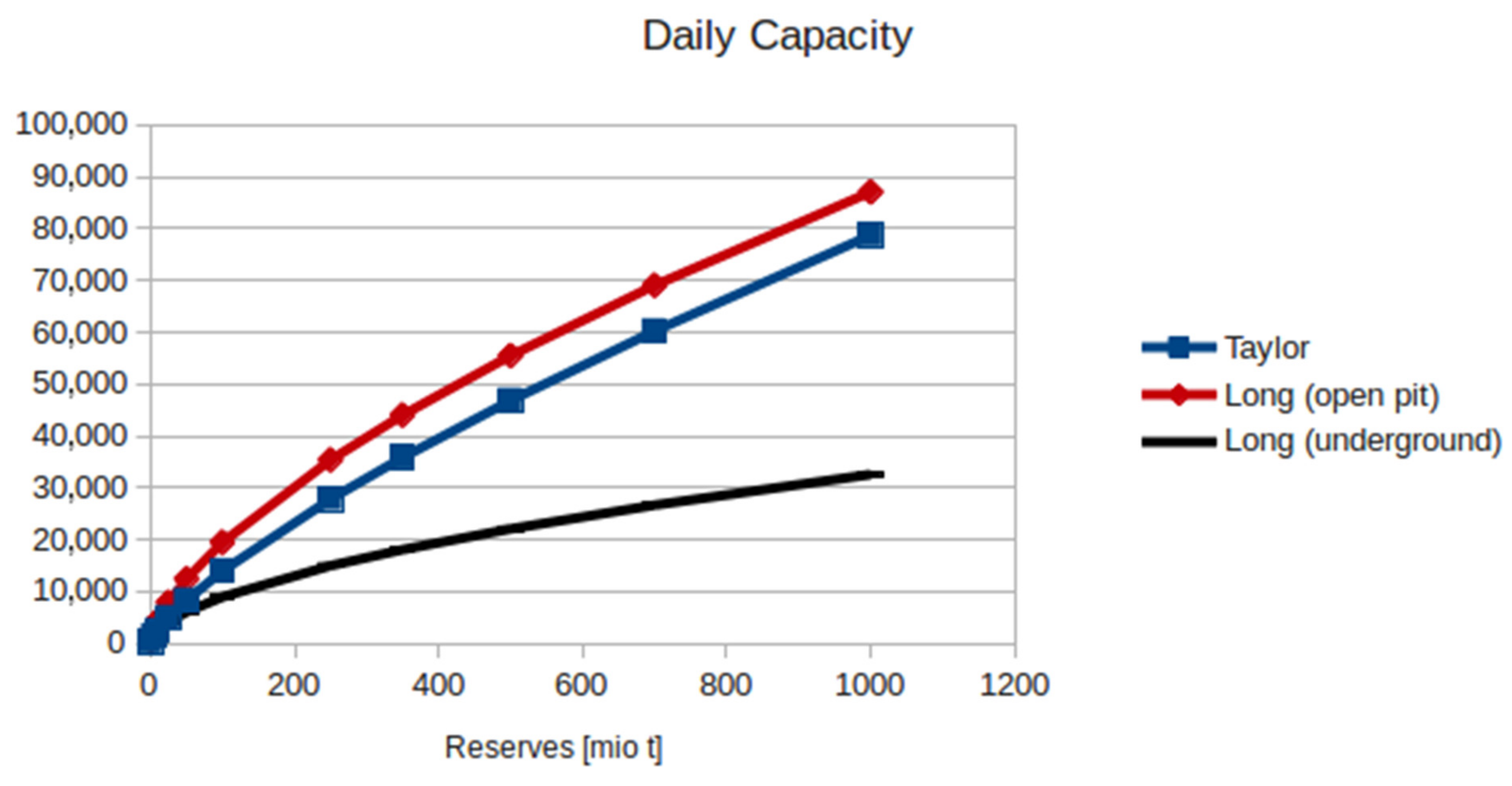
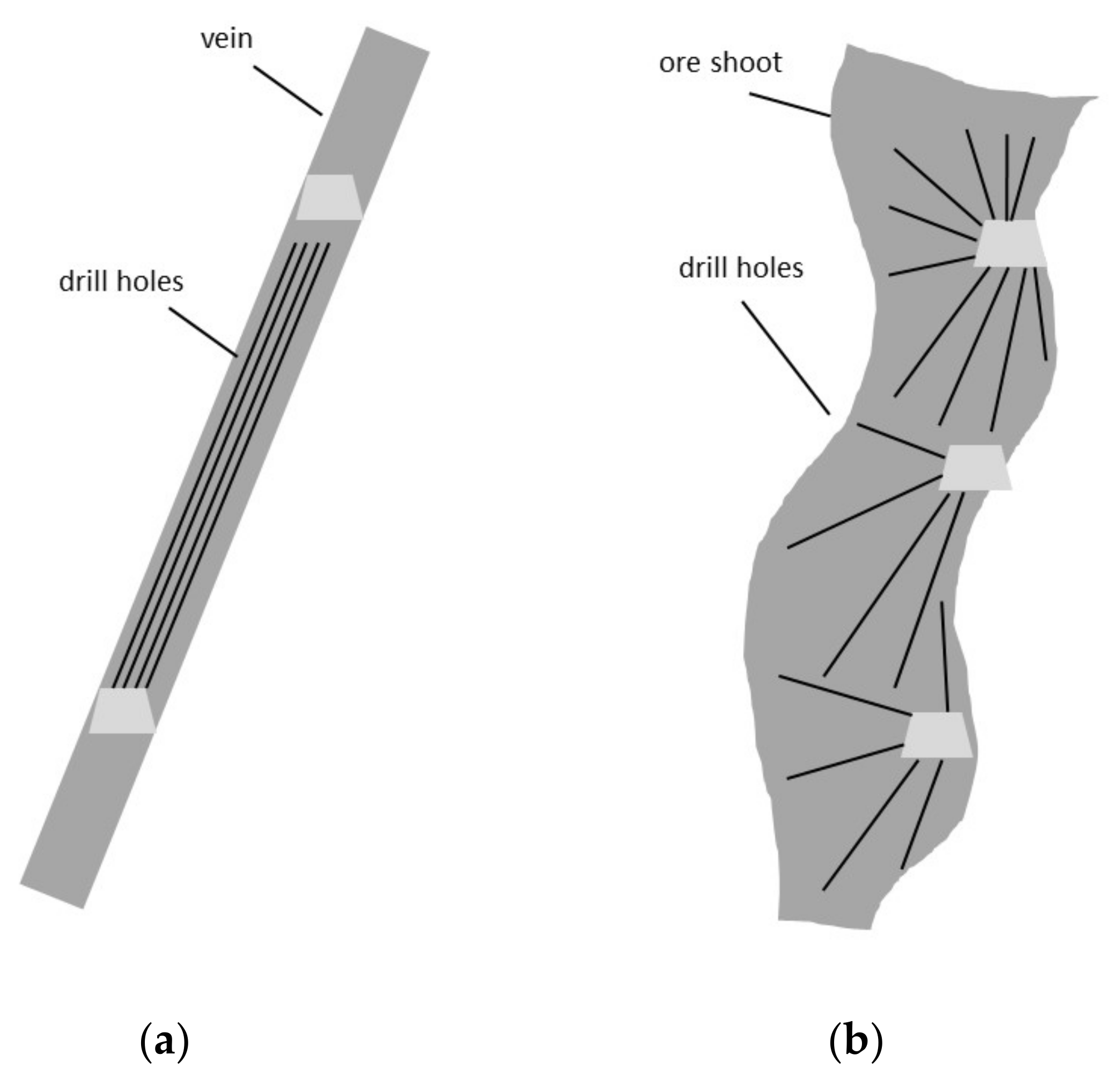
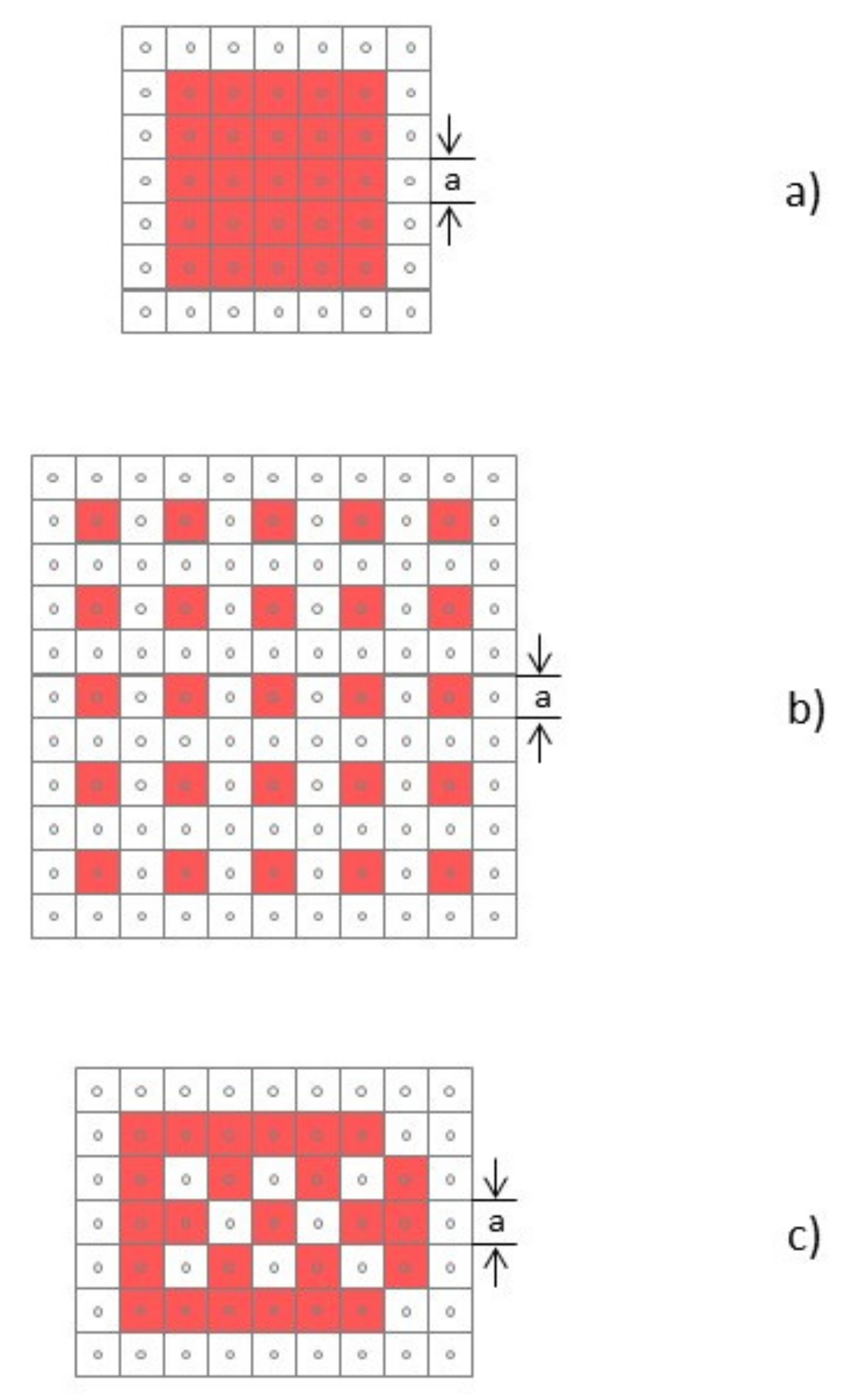
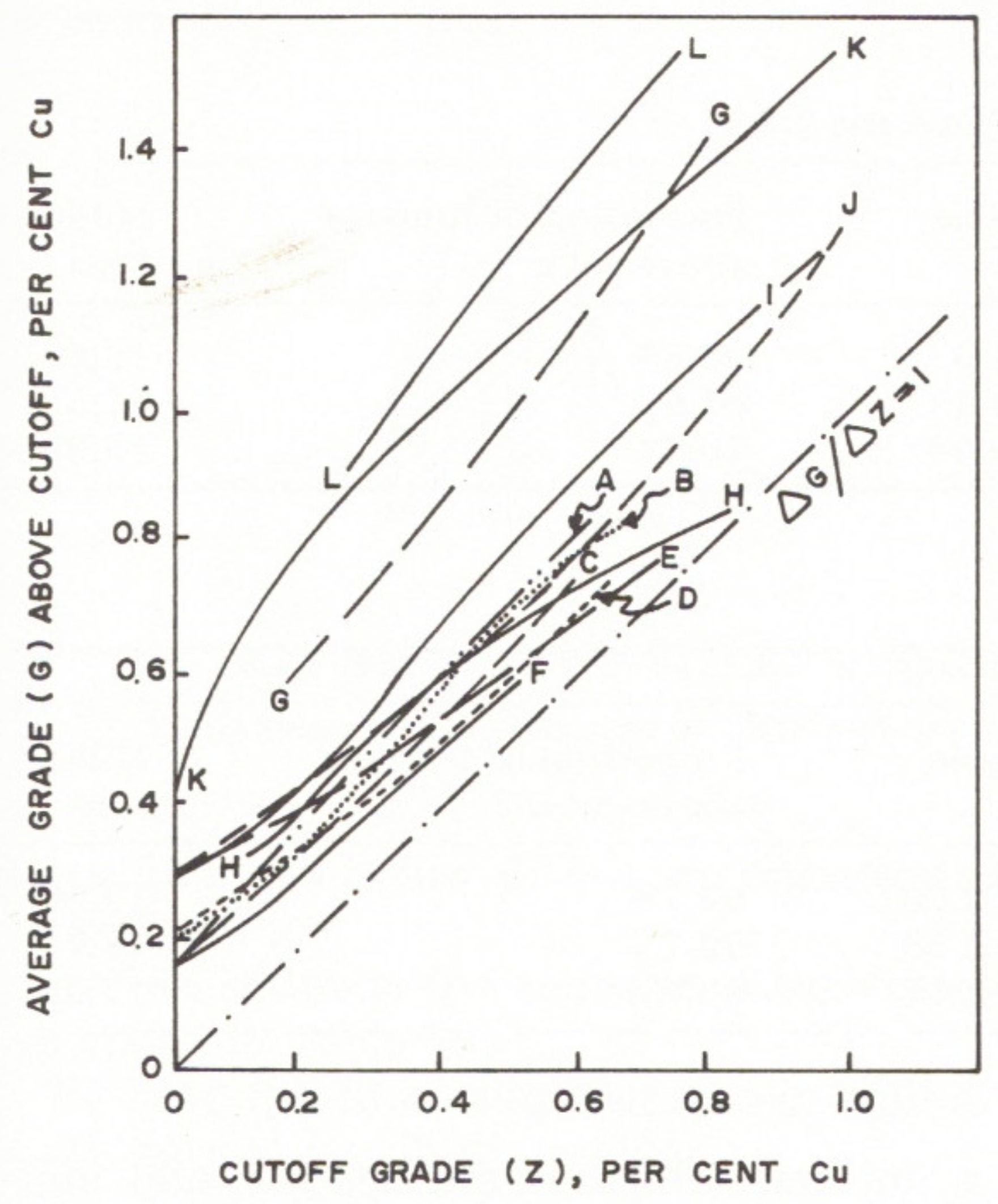
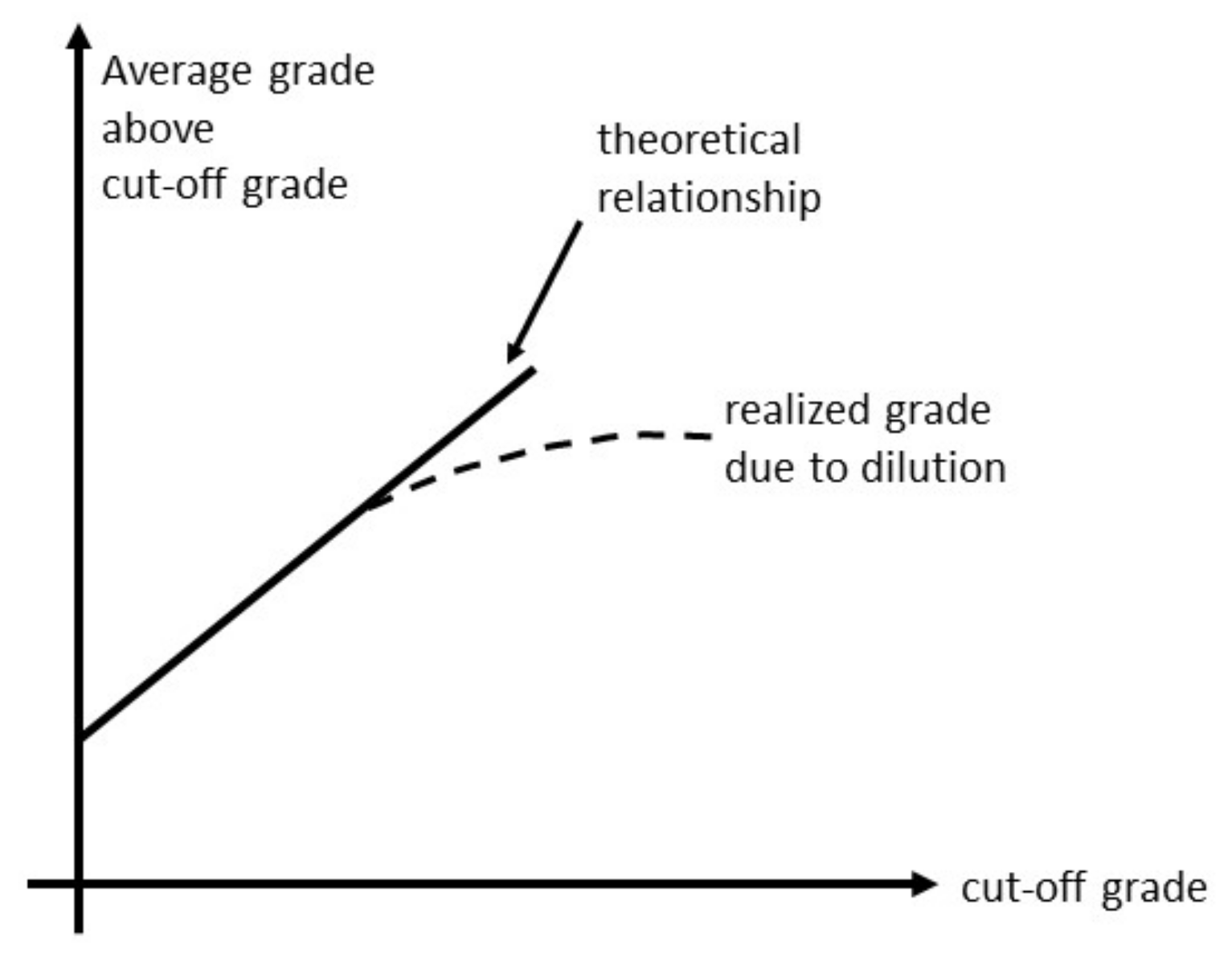
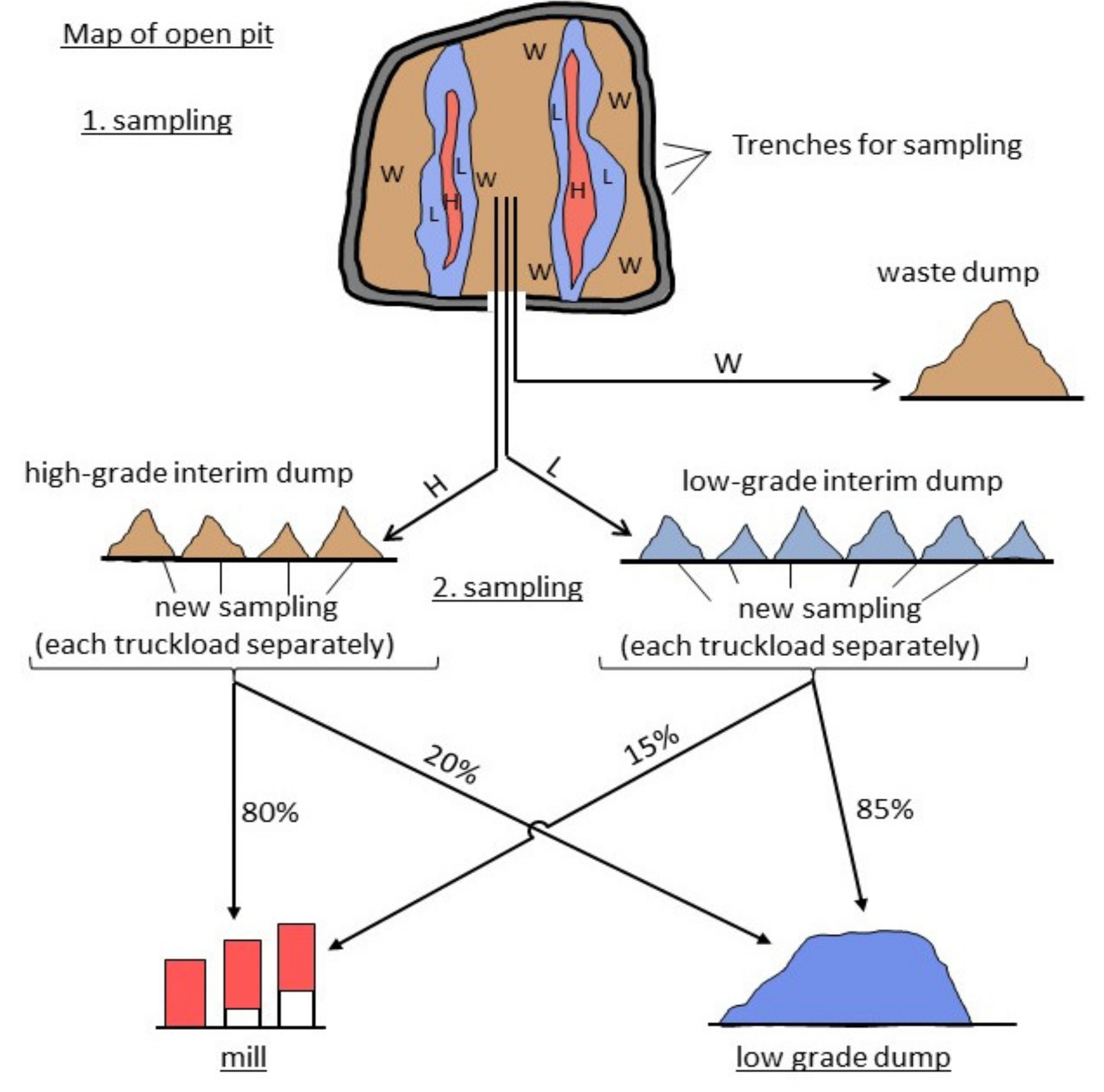
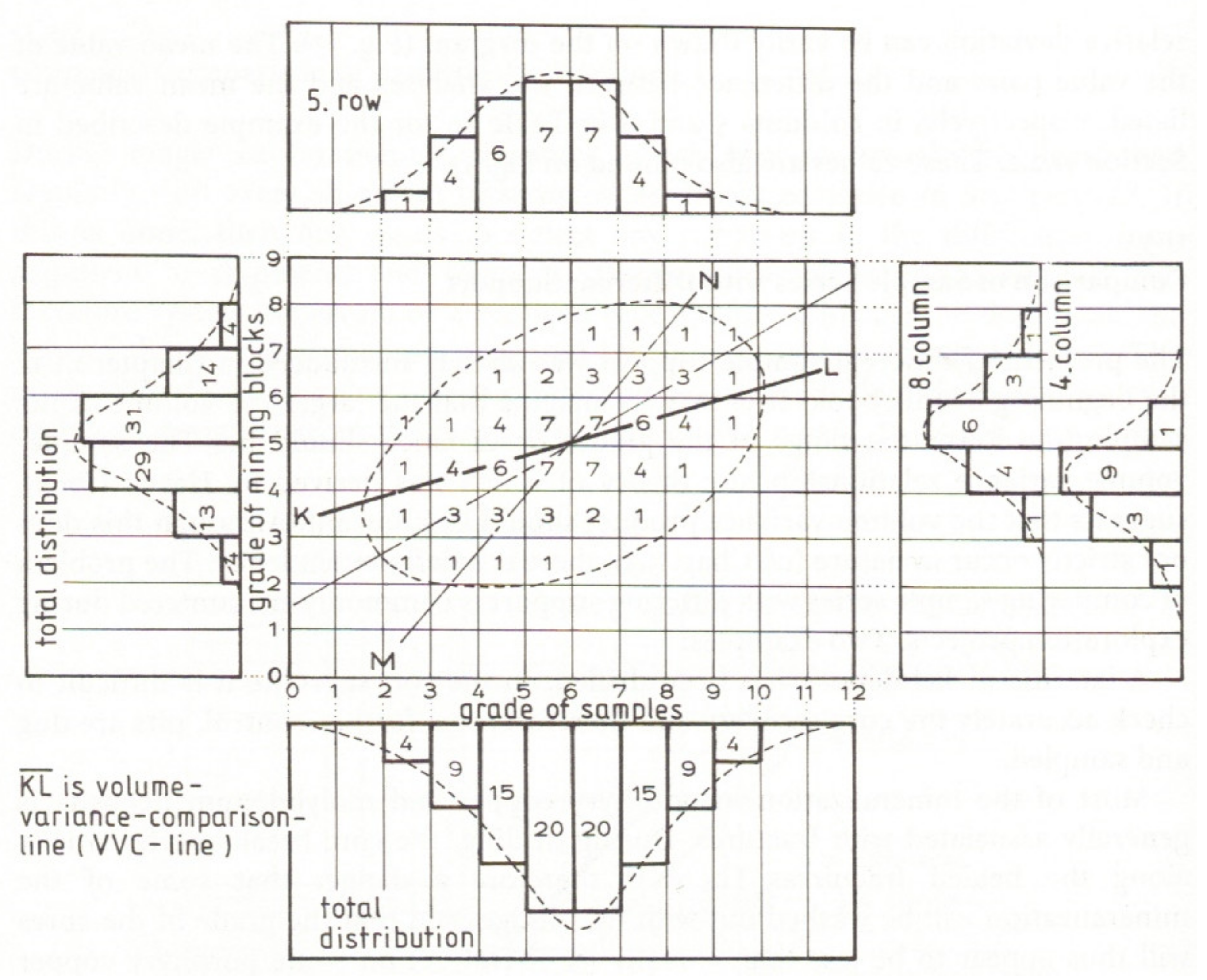
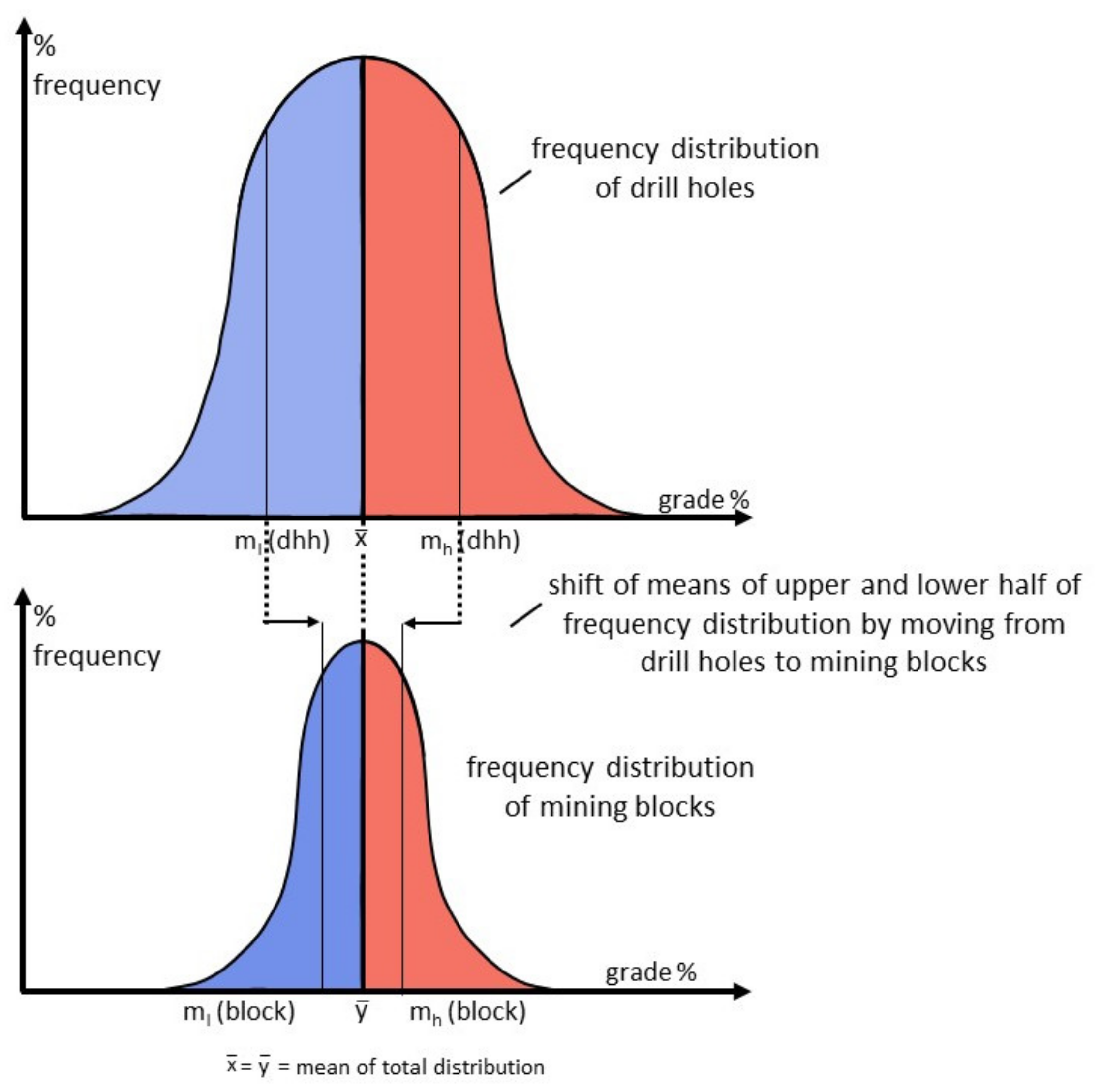

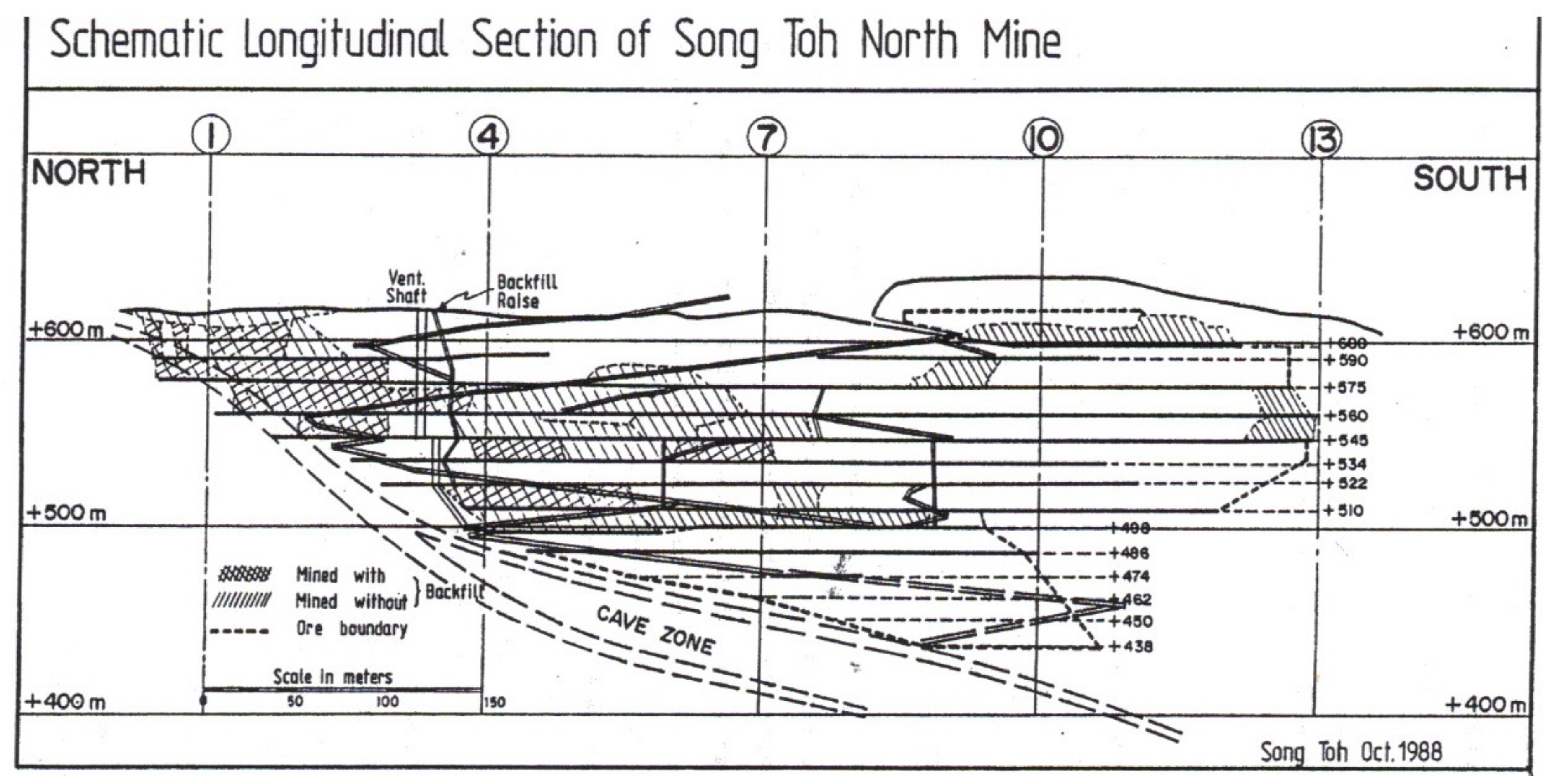
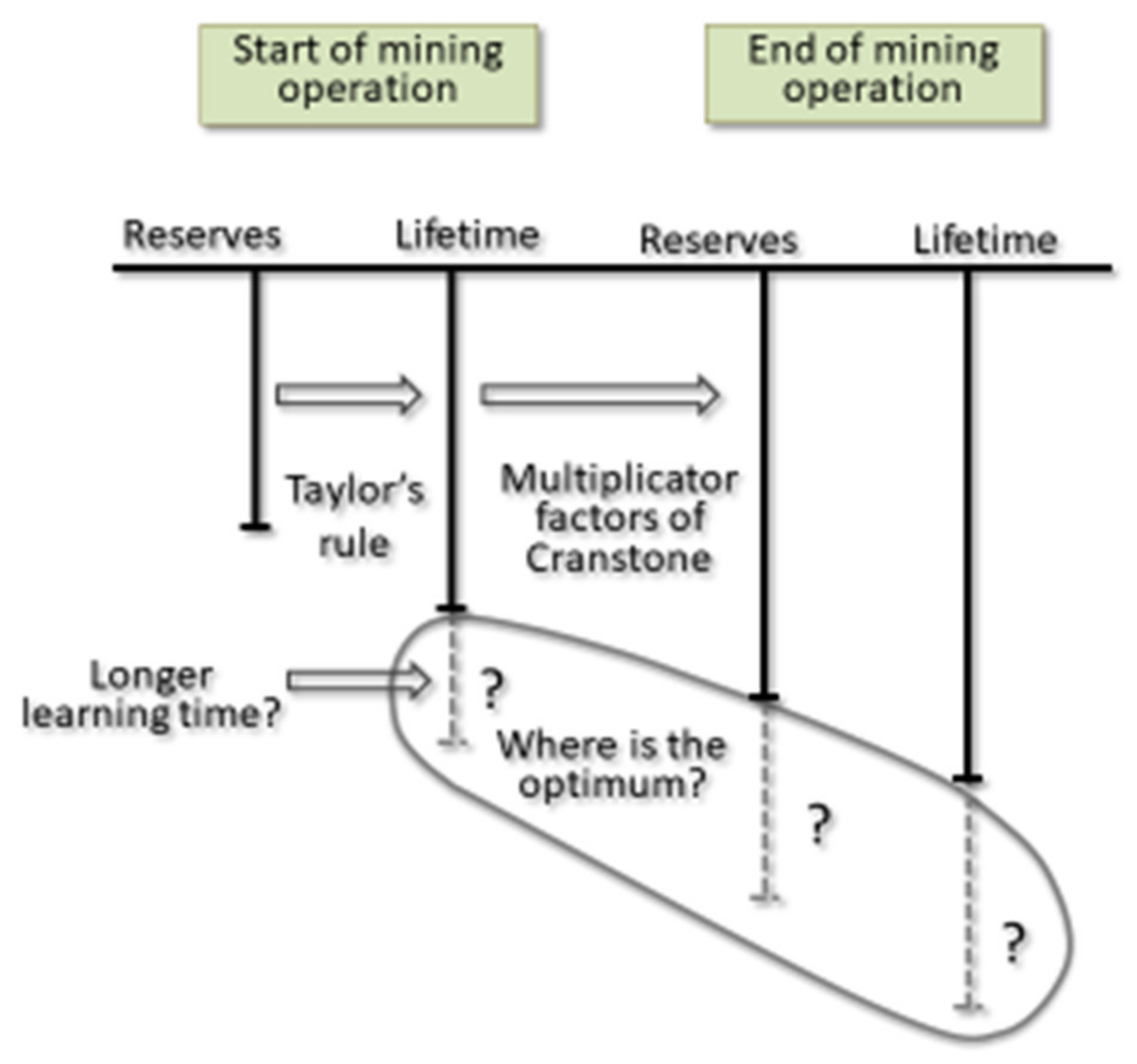
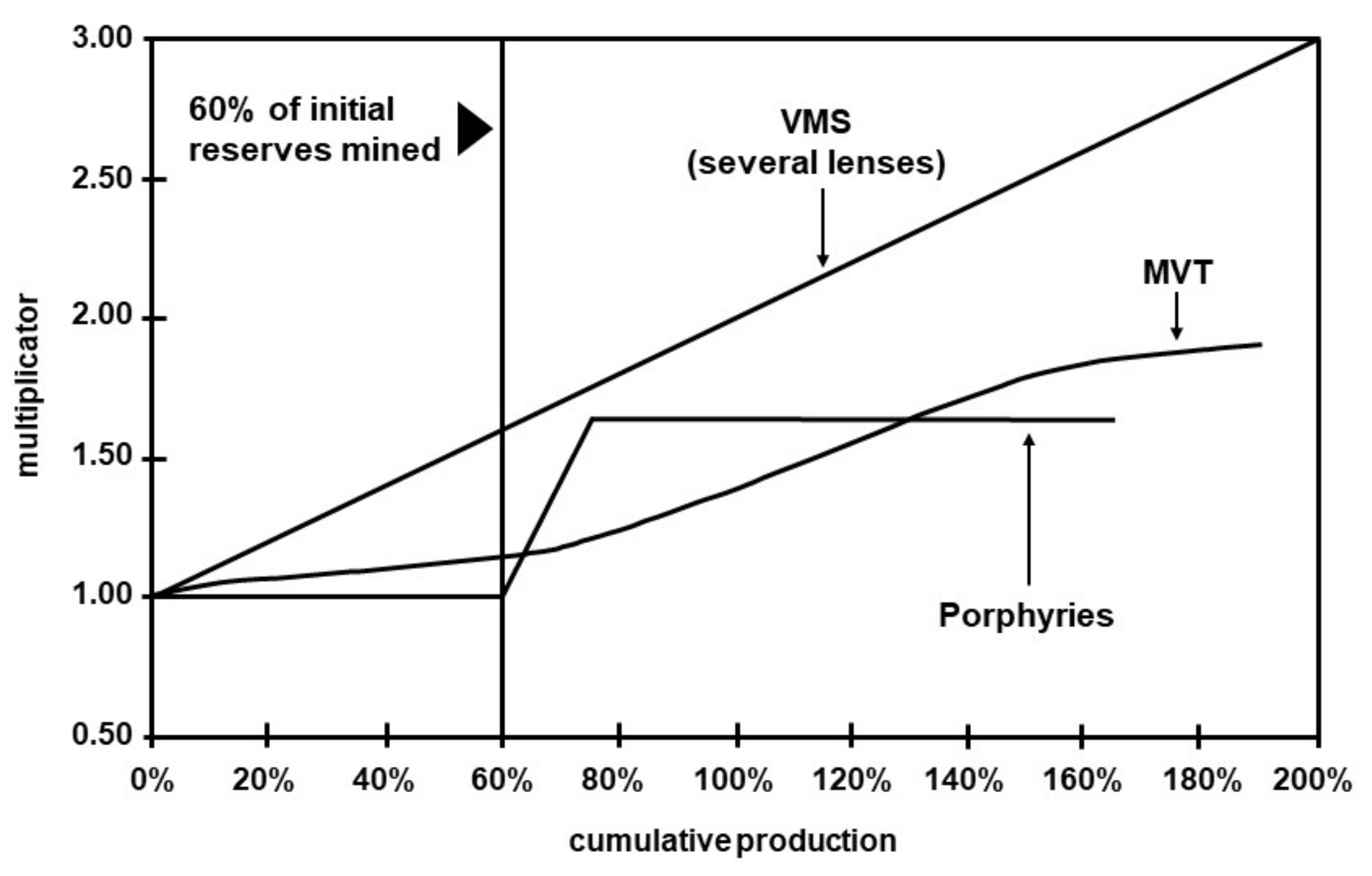
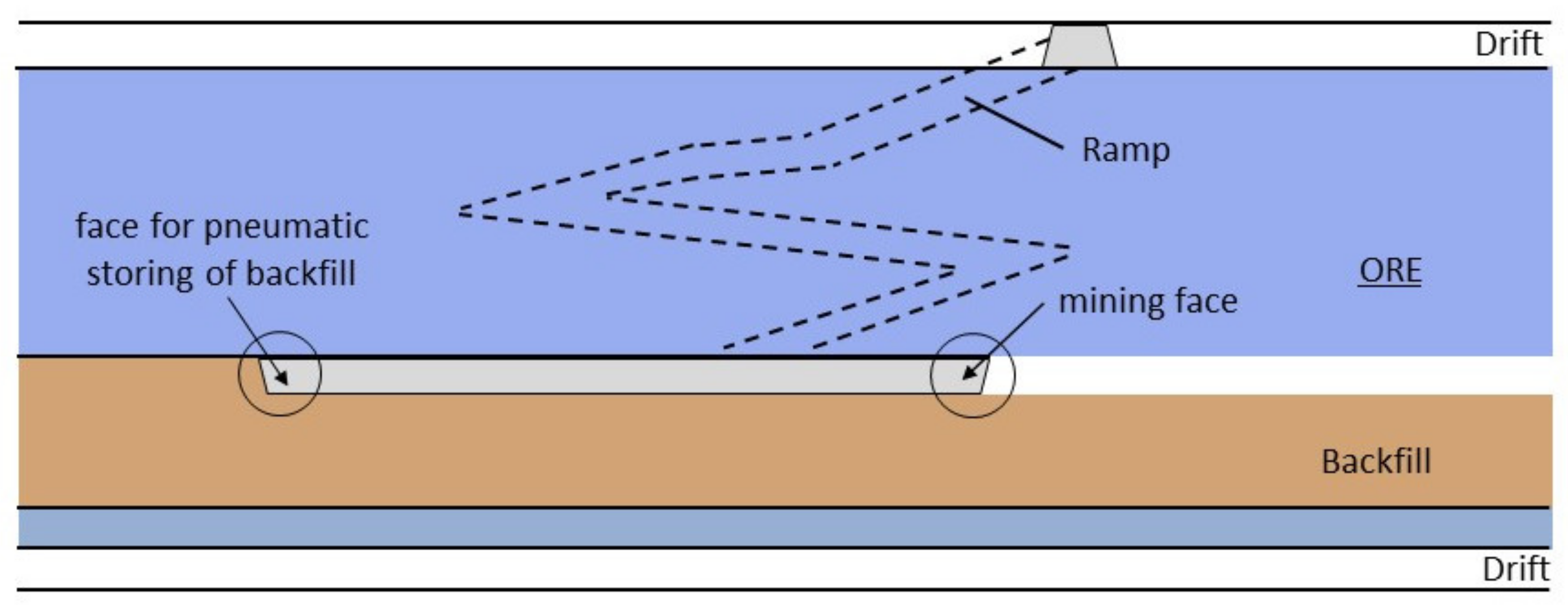
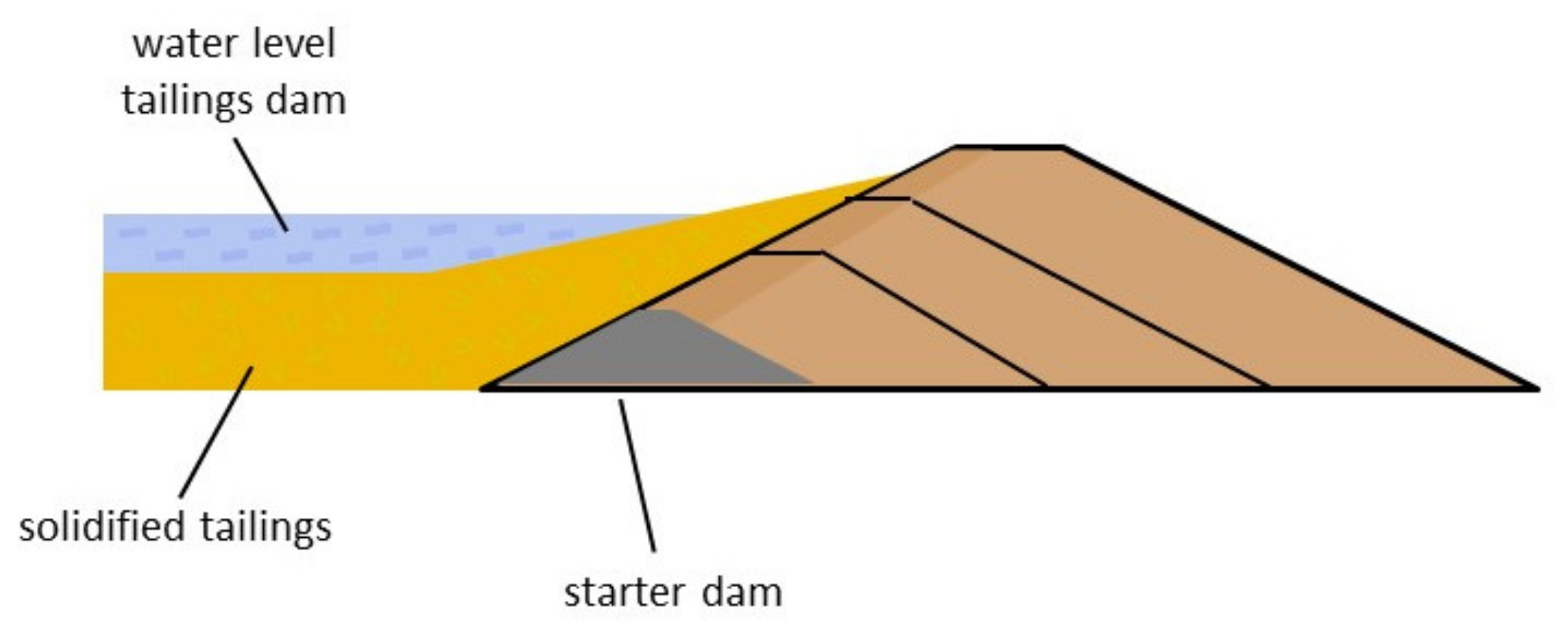

| 1. Detailed Reconnaissance | 2. Detailed Surface Prospection | 3. Drill Target Identified | 4. New Mineralization | 5. New Mineralization with Some Tonnage | 6. Orebody Outlined | 7. New Ore Deposit (Mineable) |
|---|---|---|---|---|---|---|
| 1:800 | 1:700 | 1:90 | 1:16 | 1:3 | 1:2 | 1:1 |
| Commodity | Estimated Share from ASM |
|---|---|
| Cobalt | 10% |
| Gold | 25% |
| Diamonds | 20% |
| Sapphire | 80% |
| Silver | 7% |
| Tantalum | 26% |
| Tin | 25% |
| Tungsten | >6% |
| Country | Mineral Raw Material Contribution to Gross Domestic Product | Mineral Raw Material Contribution to Exports |
|---|---|---|
| Botswana | 19.2% | 91.7% |
| Bolivia | 12.1% | 45.7% |
| Brazil | 4.8% | 7.3% |
| Chile | 19.8% | 53.4% |
| Country | Share of ASM in Mineral Production | Mineral Raw Material’s Contribution to Gross Domestic Product | Mineral Raw Material’s Contribution to Exports |
|---|---|---|---|
| Eritrea | 20 to <30% | 28.7% | 42.2% |
| Central African Rep. | 20 to <30% | 0.6% | 15.8% |
| Sierra Leone | 20 to <30% | 9.7% | 50.8% |
| DR Congo | 10 to <20% | 42.4% | 80.4% |
| Mongolia | 10 to <20% | 25.8% | 45.3% |
| Zimbabwe | 10 to <20% | 18.8% | 54.3% |
Publisher’s Note: MDPI stays neutral with regard to jurisdictional claims in published maps and institutional affiliations. |
© 2022 by the author. Licensee MDPI, Basel, Switzerland. This article is an open access article distributed under the terms and conditions of the Creative Commons Attribution (CC BY) license (https://creativecommons.org/licenses/by/4.0/).
Share and Cite
Wellmer, F.-W. Geology and Mining: A Symbiotic Cooperation?! Mining 2022, 2, 402-424. https://doi.org/10.3390/mining2020021
Wellmer F-W. Geology and Mining: A Symbiotic Cooperation?! Mining. 2022; 2(2):402-424. https://doi.org/10.3390/mining2020021
Chicago/Turabian StyleWellmer, Friedrich-W. 2022. "Geology and Mining: A Symbiotic Cooperation?!" Mining 2, no. 2: 402-424. https://doi.org/10.3390/mining2020021
APA StyleWellmer, F.-W. (2022). Geology and Mining: A Symbiotic Cooperation?! Mining, 2(2), 402-424. https://doi.org/10.3390/mining2020021






